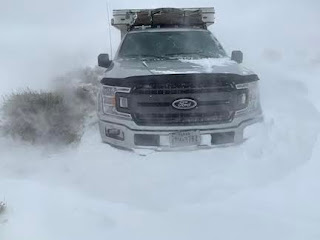We are turning towards home now. One of our favorite places to stop before we make the shift from moseying home to full throttle is to visit the Onaqui wild horse herd near Dugway, Utah.
We spent the night in a motel in Tooele. The laundry just couldn’t wait. We also needed to re-provision and fill the water tank. We were also fortunate that dear friends agreed to meet us for lunch. We had much to catch up on and didn’t arrive at our favorite camping spot until after five. Our campsite is on a bluff below a ridge. From here we can see miles into the distance and keep better track of the constantly moving wild horse herds.
We saw a herd below us in the valley, but they were over a mile away. A small herd of pronghorn dashed across the ridge. These creatures are the fastest land mammal in North America, reaching speeds of 55 mph. We had seen a man driving an ATV and holding a rifle. It appeared that he must have missed his shot.
We settled in for the evening, scanning the area with binoculars. To our complete surprise, we saw nearly 60 horses coming over the ridge. They were in a fast trot, heading to the water tank over the other side. Wow! It was such fun to see so many horses so soon in our visit. We have often gone days without catching more than a glimpse of these majestic creatures.
The next morning we found the herd grazing not far from the water tank. We walked around them, taking photos. There were a half dozen other photographers sharing the space. Most everyone kept a respectful distance. Unfortunately we have seen too many walk right up to the horses. We were definitely grateful for our long-range lenses. We were also happy to find old friends, including our renegade painted stallion who always seems to cause trouble.
We decided to drive to another water tank in the area. It is not a very photogenic place, but with the drought, it was almost a guarantee that we would see more horses. Between ten in the morning and four in the afternoon are the dead times for a photographer because the sun is too harsh. We drove around, waited at the tank, and tried to amuse ourselves.
As we were heading back to our campsite, we saw a large herd of horses running across the road and heading west. We stopped to take photos. My camera could barely focus with all the dust they were kicking up. We finally realized they were heading to an old stock pond. It had been dry during our last visit, but they must have repaired it. We hopped in the truck and barely beat the horses to the tank before they arrived.
It was such fun to watch. They came running to the pond, some at a gallop. They splashed and pawed at the water.
Some horses waded in while others rolled in the water. When one group had their fill, others would take their place. The wet ones would roll in the dust. Mothers would nurse their foals while tussles would break out amongst the stallions. Even a herd of pronghorn joined the herd to quench their thirst. We watched with sheer joy. Finally, all the horses had their fill, and various groups wandered off, grazing.
We returned to our camp spot, relishing the moment we had just encountered. It was just beginning to get dark when we heard a clopping nearby. A giant dark shadow came towards us. Three bachelor stallions walked right past our camp. What a glorious ending to a wonderful day.
The next morning, we returned to the stock pond and found the herd grazing nearby. They were on the move, however, and weren’t extremely cooperative in getting their photo taken. It could have been because of the bombs going off at the Dugway proving grounds. They were having military exercises, and every so often a huge explosion would jolt us all.
After ten o'clock, we decided to take a drive over to Fishing Springs Wildlife Refuge. It is a beautiful, spring-fed wetland in the middle of the desert and a migration point for waterfowl. While we were too early for migration, we did find some interesting birds and a very scrawny coyote looking for a meal.
On our way back to camp, we found our herd again, heading to the stock pond. This time they were much more subdued. But it was still fun to watch them.
We arrived back at our camp and were surprised to find a small band of horses grazing just a few yards from our usual place. Even more surprising, they stayed nearby for several hours after we set camp. Pronghorn grazed below us. We watched one small prong buck challenge and circle a larger buck. It was amazing.
We had decided to stay another full day if our good fortune continued. Unfortunately, we both awoke to the smell of smoke. David checked the area while I dressed. He spied two antelope fighting in the distance and managed to take some video.
Still we smelled smoke. The area seemed clear, but after our morning stroll, we could see smoke drifting over the mountain. We broke camp and drove to the stock pond. Halfway there, we were engulfed in smoke. It appeared that the proving grounds had a rather large grass fire, perhaps intentional because several crews were still overseeing the area.
The horses had vanished. The entire area was covered in such dense smoke that it would have been unhealthy to stay. We had no recourse except to leave the area. It was a bittersweet ending to a marvelous opportunity with these wonderful creatures. It was, indeed, incredible!





















































